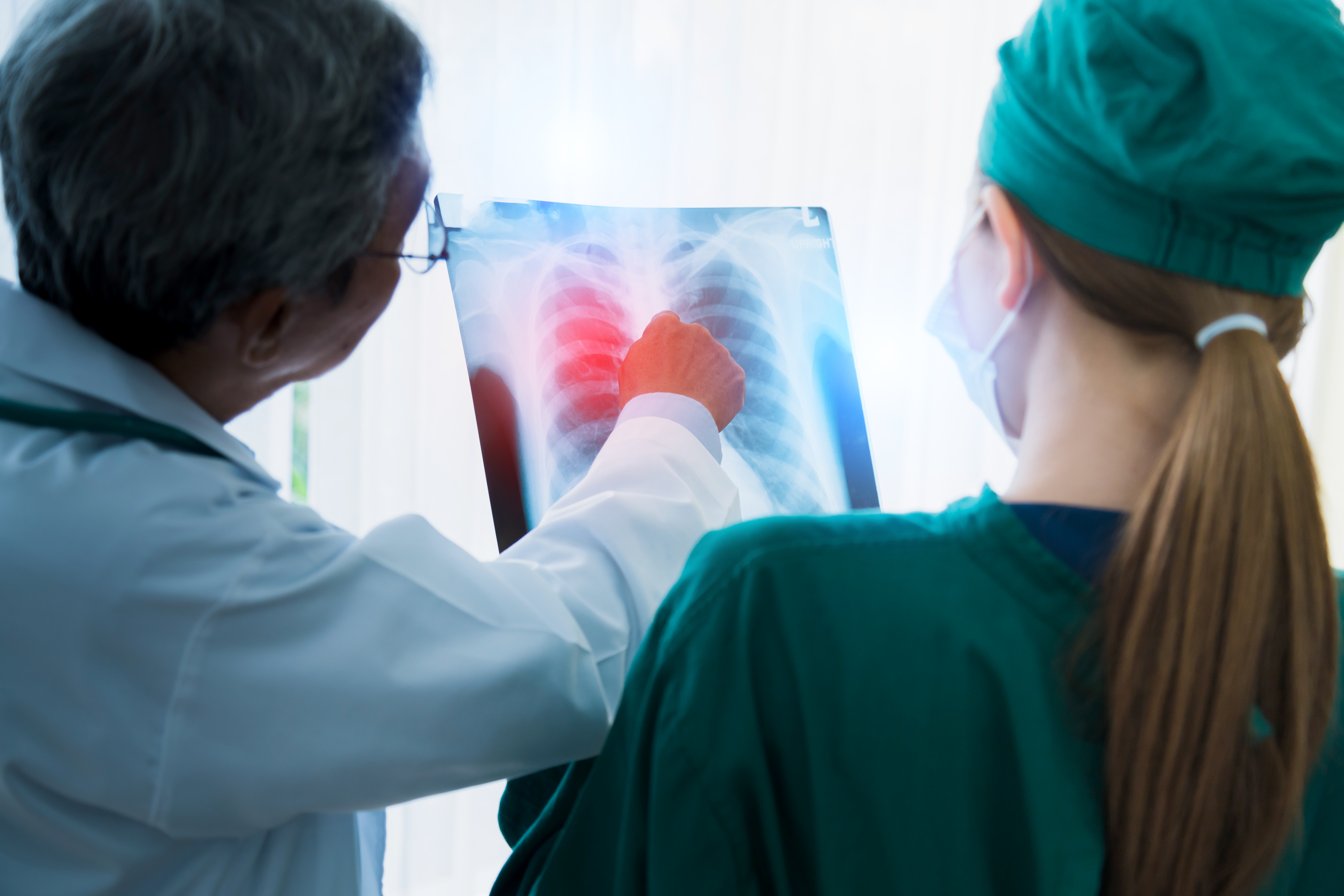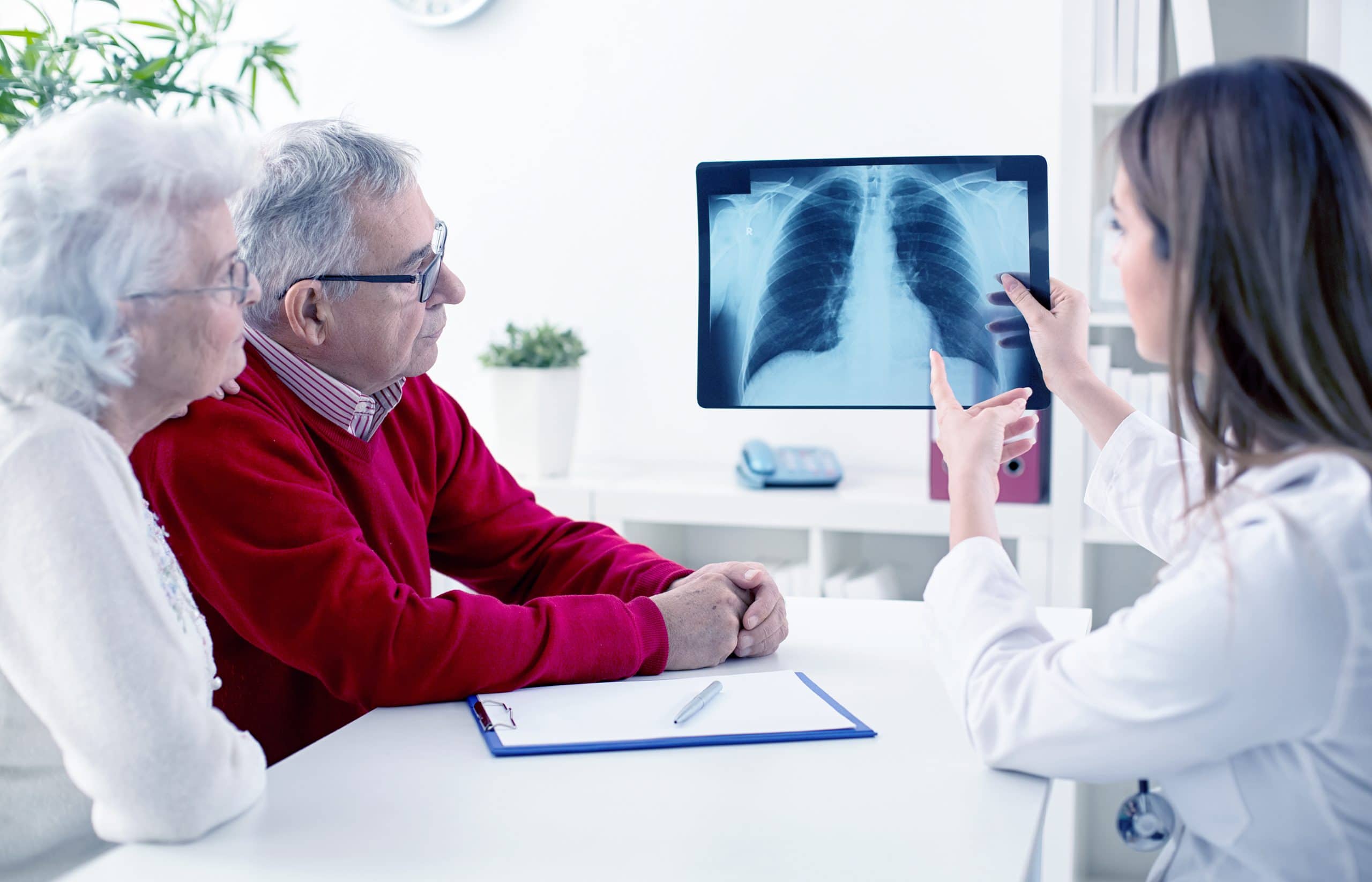Pulmonary Edema - Fluid in Lungs
Pulmonary edema is an accumulation of extravascular fluid in the lungs affecting the respiratory system, making it difficult to breathe. For those suffering from lung cancer, the respiratory system is a common site for complications after undergoing cancer treatments.

Is Pulmonary Edema a Sign of Lung Cancer?
For those suffering from lung cancer, the respiratory system is a common site for complications, such as pulmonary edema, after undergoing cancer treatments. It is an accumulation of extravascular fluid in the lungs, and for many people, the buildup of fluid in the lungs makes it difficult to breathe.
Fluid accumulates in your lungs when your heart isn’t pumping correctly, causing blood to back up into the veins leading to your lungs. Lung cancer can be difficult to navigate, and complications can arise, so we’ve gathered everything you need to know about pulmonary edema.
What are the Causes of Fluid in the Lungs?
When fluid in the lungs is caused by a heart problem, such as congestive heart failure, it’s known as cardiogenic pulmonary edema (CPE). It occurs when the left ventricle stops pumping blood and instead causes it to build up in the blood vessels in your lungs. As the pressure continues to increase, the fluid is forced into the air sacs in your lungs, leading to wheezing and chest tightness.
On the other hand, noncardiogenic pulmonary edema occurs when diseases other than heart problems inflame or damage your lungs. It’s caused when the capillary permeability, the inner lining of the blood vascular system, increases and becomes inflamed. As the blood vessels become inflamed, it creates leaky blood vessels, allowing fluid into the lungs. Some common heart problems that can lead to cardiogenic pulmonary edema are:
- Heart attacks.
- High blood pressure.
- Abnormal heart rhythm.
- Weakened heart muscles.
- Leaky heart valves.
Common causes of noncardiogenic pulmonary edema include:
- Acute kidney disease.
- Allergic reactions.
- Pneumonia.
- Pancreatitis.
- Liver disease.
What are the Different Types of Pulmonary Edema?
There are three different types of pulmonary edema: sudden (acute) pulmonary edema, high-altitude pulmonary edema (HAPE), and long-term (chronic) pulmonary edema. Your symptoms will differ based on your type and can suddenly appear or develop over time.
High-altitude pulmonary edema is noncardiogenic and affects those who ascend rapidly to altitudes higher than 2500-3000 m. It occurs when the blood vessels in the lungs squeeze tightly together, increasing pressure and causing fluid to leak into blood vessels, lung tissue, and air sacs. Acute pulmonary edema is cardiogenic and requires emergency management due to its high mortality rates from fluid in the lungs. Lastly, long-term pulmonary edema has the same symptoms as acute pulmonary edema but a milder version.
Pulmonary Edema Prevention Tips
Medical intervention and treatment are crucial for those suffering from pulmonary edema because if it is left untreated, it can lead to respiratory failure or, at times, death. According to the National Library of Medicine, your prognosis is based on your underlying medical condition. Still, typically, CPE patients have an in-hospital death rate of 15-20%, a one-year survival rate of 50%, and after the 6-year follow-up, the death rate rises to 85%. You can make many small changes to your everyday routine that will help lower your chances of developing pulmonary edema and prevent fluid in the lungs. Easy changes you can make to your everyday routine can be:
- Managing your blood pressure and other medical conditions is important so your heart stays healthy.
- You can keep your heart and lungs healthy by implementing a new diet (particularly one with less salt) and avoiding smoking.
- Eating healthy and exercising regularly will also help you manage your weight and lower your chances of developing cardiovascular disease.
For legal compensation information, fill out a free case evaluation form today.
Pulmonary Edema Symptoms and Diagnosis
Pulmonary edema symptoms can come on suddenly or develop over time. Those suffering from cardiogenic pulmonary edema will experience symptoms suddenly and more intensely than those who suffer from noncardiogenic pulmonary edema. Many people who experience symptoms report feeling like they are drowning or suffocating. We recommend seeking immediate medical attention if you or a loved one suddenly experiences any of the following symptoms of fluid in the lungs:
- Shortness of breath.
- Coughing up blood.
- Wheezing.
- Chest and lung pain.
- Irregular heartbeat.
- Swelling in your legs.
- A feeling of drowning when lying down.
- Rapid weight gain.
If you are experiencing any of the symptoms above, a healthcare professional can diagnose you through physical examinations, imaging testing such as chest X-rays, and other diagnostic tests.
Fluid in the Lungs Treatment Options
The main types of pulmonary edema treatments include medications, lifestyle changes, and, in some cases, medical procedures to remove the fluid in the lungs. Healthcare providers will begin with oxygen therapy to ease your symptoms and improve your breathing. The severity of your condition will determine what treatment options are available to you. No matter what treatment option you choose, it’s important to manage your underlying health condition to prevent reoccurring episodes in the future.
Treating Pulmonary Edema with Medications
Your healthcare provider may recommend using medications to treat your pulmonary edema. These medications can help remove excess fluid in the lungs, lower your blood pressure, and improve your heart health and function. All medications have side effects, and some common side effects of pulmonary edema medications are headaches, urinary frequency, weakness, fatigue, and restlessness.
Your healthcare provider may recommend one of the following medications based on your symptoms and underlying health conditions:
- Diuretics: Decreases the pressure caused by the fluid in your lungs.
- Blood Pressure Drugs: Manges your blood pressure, which may rise or drop with fluid in the lungs.
- Inotropes: Given through an IV and are for people in the hospital suffering from heart failure. Inotropes help your heart pump correctly while maintaining healthy blood pressure.
- Morphine: Helps to relieve shortness of breath and anxiety. Many healthcare providers will not recommend this medication.
Treating with Lifestyle Changes
Lifestyle changes will improve your heart health and help with some of the symptoms you are experiencing. We recommend implementing as many of these as you can into your daily routine to reduce the fluid in the lungs:
- Eat less salt: Salt retains fluid, and too much of it can trigger congestive heart failure.
- Don’t smoke: If you haven’t started smoking, don’t start, and if you have, it’s always a healthy idea to stop smoking.
- Eat a healthy diet: Make sure you are eating plenty of fruits, vegetables, and whole grains. Limit your intake of added sugars, sodium, and fats.
- Watch your weight: Being overweight puts you at risk for cardiovascular disease. Losing weight will lower your risk of cardiovascular disease, diabetes, high blood pressure, and high cholesterol.
- Exercise regularly: It’s recommended that adults get 150 minutes of moderate physical activity a week. Before starting an exercise program, talk to your healthcare provider about the amount of exercise your body can handle.
Treating with Medical Procedures
Some people may not tolerate medications, or their condition may be so severe they end up in the emergency room. For these patients’ healthcare providers may try:
- Ultrafiltration: For patients with renal dysfunction and diuretic resistance, ultrafiltration removes the fluid in the lungs. Some cardiovascular side effects include cell death, decreased blood pressure, and hypotensive episodes.
- Intra-aortic balloon pumping: Improves coronary blood flow and stabilizes the patient before definitive therapy. Although complications are rare, they are still possible. Some complications associated with intra-aortic balloon pumping are strokes, low platelet count, bleeding, or injury to an artery.
- Airway pressure machines: Short-term solution for patients with respiratory failure. Airway machines can cause various side effects, such as infection, dry mouth, trouble clearing phlegm, sinus pain, and eye irritation.
Can I be Compensated for Pulmonary Edema?
Suppose your underlying condition was caused by exposure to asbestos or toxic chemicals. In that case, you may qualify for compensation, as being exposed to asbestos or toxic chemicals can lead to developing pulmonary edema. Treating fluid in the lungs isn’t cheap, but it is necessary to receive it promptly. Patients usually develop symptoms over hours or days, and with treatment, their lungs may return to normal 24 hours after treatment. We understand that not everyone has the finances for their treatment expenses, and the Lung Cancer Center is here to provide support and resources to help you navigate your cancer journey. If you or a loved one is suffering from pulmonary edema, don’t hesitate to reach out to one of our patient advocates today.


